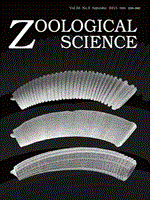Triops granarius (Lucas) is a freshwater crustacean that is distributed from South Africa to the Eurasian continent. This species lives in temporary water pools and is exposed to desiccation and extreme temperatures after the water dries up in its habitat. To withstand this severe environment, Triops eggs enter anhydrobiosis when dehydrated. To clarify the physiological characteristics of T. granarius anhydrobiosis, we examined hatching rates after rehydration of eggs that were dehydrated at several humidity levels for 10 or 100 days. Lower humidity produced higher hatching rates when dehydration was continued for 100 days. These results suggest that drying at low humidity is required for long-term anhydrobiosis of T. granarius eggs. The eggs survived desiccation when dehydrated at the blastula, gastrula, and early organogenesis stages. The most dehydration-tolerant stage was early organogenesis. Non-dehydrated eggs hatched after temperature treatments of up to 50°C for 1 h, but did not hatch after exposure to 60°C for 1 h in air and under water. Similar results were obtained for dehydrated eggs exposed to high temperatures under water. In contrast, dehydrated eggs hatched after 1 h at 80°C in air but did not after 1 h at 90°C in air. Our results show that Triops eggs exhibit tolerance for desiccation and high temperature in a dried state, once they have entered anhydrobiosis.
How to translate text using browser tools
1 September 2013
Desiccation and Heat Tolerance of Eggs of the Asian Tadpole Shrimp, Triops granarius
Chihiro Ito,
Shin G. Goto,
Hideharu Numata
ACCESS THE FULL ARTICLE

Zoological Science
Vol. 30 • No. 9
September 2013
Vol. 30 • No. 9
September 2013
anhydrobiosis
dehydrated eggs
Desiccation
embryonic development
high temperature
water content




